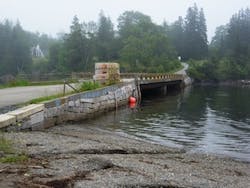Maine Bridge Uses First GRS Wall in a Marine Environment
In 2013, the town of North Haven, Maine, began construction on bridge project that was the first of its kind. The goal was to rebuild a deteriorating bridge that provided access to four seasonal homes and was an important wharf for the local lobster industry.
The town faced several challenges with this project:
• North Haven is an island located on the coast of Maine; all construction materials and equipment had to be transported to the island by boat.
• The town wanted to integrate an existing pier to minimize construction time and costs.
• Construction needed to be completed during the winter and early spring to minimize the impact on residents and fishermen.
• The wall had to withstand potential impact from the boats navigating the waterway.
The solution
The remote location of North Haven led the design team to search for a solution simpler than a typical pile-driven foundation for the bridge abutments. The solution was a geosynthetic reinforced soil (GRS) integrated bridge system (IBS) using Redi-Rock as the wall-facing unit, completed as a joint effort of the Town of North Haven and the Maine Department of Transportation (DOT).
“A GRS wall was by far the cheapest and easiest to incorporate in that type of environment,” said Josh Olund, P.E., of T.Y. Lin International. “This is the first time a GRS wall has been used in a marine or tidal environment. It’s also the first time being used in a two-span bridge arrangement.”
The main difference between a GRS wall and a traditional mechanically stabilized earth abutment wall is that reinforcing fabric is used in much more closely spaced layers, and the fabric is not geogrid.
“What’s typically used is more like a filter fabric,” said Jeff Benway, P.E., of SFC Engineering Partnership Inc. “It doesn’t have the same strength as geogrid, but it’s much more closely spaced—every 6 to 9 in. (150 to 230 mm) versus every 18 in. (457 mm) with a traditional Redi-Rock wall. This allows the fabric to act as a tension element in the soil. The facing unit isn’t really retaining the soil at all; it’s simply preventing erosion of the reinforced soil mass.”
Redi-Rock is a large block retaining wall system that can be used to build tall gravity walls and even taller reinforced walls. It is also a great option for GRS–IBS projects because it allows the installation crew to compact the reinforced soil mass right up to the back of the blocks. The massive size of each Redi-Rock block allowed the facing structure to handle compaction of the soil directly behind it. Redi-Rock is also a great solution for storm channels, retention ponds and shoreline protection.
Using lightweight concrete beams allowed designers to reuse an existing bridge pier to cut down on cost and time. The limestone-textured Redi-Rock blocks matched the aesthetic look of the existing bridge pier and fit in with the natural look of the environment.
The results
Redi-Rock of Central Maine supplied the zero-batter Redi-Rock blocks. Since the bridge abutment is partially submerged in the ocean at high tide, the blocks were cast using a low-permeability concrete mix that met all Maine DOT specs. These blocks were unique in that they required flat tops and bottoms with no shear knob or groove—standard parts of any Redi-Rock block. This custom block design allowed the geosynthetic fabric to be sandwiched between the flat blocks. The design also included intermediate, non-attached layers of Tencate Mirafi HP 770PET fabric located at mid-height of the blocks (every 9 in. or 230 mm).
At the tallest point, the abutment walls stand 15 ft (4.57 m) tall, with 4 ft (1.22 m) buried. The project included a total of 344 Redi-Rock blocks, equaling 1,918 sq ft (178.19 sq m).


